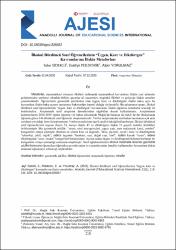| dc.contributor.author | Sidekli, Sabri | |
| dc.contributor.author | Pekdemir, Esadiye | |
| dc.contributor.author | Yorulmaz, Alper | |
| dc.date.accessioned | 2022-06-14T13:26:34Z | |
| dc.date.available | 2022-06-14T13:26:34Z | |
| dc.date.issued | 2021 | en_US |
| dc.identifier.citation | SİDEKLİ S,PEKDEMİR E,YORULMAZ A (2021). İlkokul Dördüncü Sınıf Öğrencilerinin “Üçgen, Kare ve Dikdörtgen” Kavramlarına İlişkin Metaforları. Anadolu Journal of Educational Sciences International , 11(1), 116 - 134. Doi: 10.18039/ajesi.826567 | en_US |
| dc.identifier.issn | 2146-4014 / 2146-4014 | |
| dc.identifier.uri | https://doi.org/10.18039/ajesi.826567 | |
| dc.identifier.uri | https://hdl.handle.net/20.500.12809/10025 | |
| dc.description.abstract | Metaforlar, matematiksel olmayan fikirleri kullanarak matematiksel kavramlara ilişkin yeni anlamlargeliştirmesine yardımcı olmakla birlikte geçmişe ait yaşantıları, bugünkü fikirleri ve geleceğe ilişkin umutlarıyansıtmaktadır. Öğrencilerin geometrik şekillerden olan üçgen, kare ve dikdörtgene ilişkin bakış açısı bukavramlara ilişkin bakış açısını yansıtması bakımından önemli olduğu söylenebilir. Bu çalışmanın amacı, ilkokuldördüncü sınıf öğrencilerinin “üçgen, kare ve dikdörtgen” kavramlarına ilişkin algılarını metaforlar aracılığı ilebelirlemektir. Araştırmada nitel araştırma desenlerinden olgubilim deseni kullanılmıştır. Araştırmanınkatılımcılarını 2018-2019 eğitim öğretim yılı bahar döneminde Muğla’da bulunan iki farklı devlet ilkokulundaöğrenim gören 146 dördüncü sınıf öğrencisi oluşturmaktadır. Veriler araştırmacılar tarafından hazırlanan açık uçlusoruların yer aldığı form ile toplanmıştır. Verilerin analizinde içerik analizi tekniği kullanılmıştır. İlkokul dördüncüsınıf öğrencilerinin üçgene ilişkin 34, kareye ilişkin 47 ve dikdörtgene ilişkin 51 geçerli metafor ürettikleribelirlenmiştir. Her geometrik şekilde, “nesne, okul araç-gereçleri, yapay yapı, yapı malzemesi, kural, sembol”kategorileri ortaya çıkmıştır. Bunlara ek olarak kare ve üçgende, “ders, yiyecek, soyut”; kare ve dikdörtgende“teknoloji, şekil, sağlık”; sadece üçgende “karakter, sayı, doğal yapı, harf”; sadece karede “oyun”; sadecedikdörtgende “uzuv, maden” kategorileri bulunmuştur. Ayrıca sadece üçgen ve dikdörtgende bulunan herhangi birkategorinin ortaya çıkmadığı sonucuna ulaşılmıştır. Sınıf öğretmenlerinin ilkokul matematik dersinde geometrikşekiller konusunu öğrencilere öğretirken çevrelerinden ve yaşantılarından örnekler kullanmaları kavramlara ilişkinanlamsal öğrenmeyi arttıracağı söylenebilir. | en_US |
| dc.description.abstract | Metaphors help develop new meanings of mathematical concepts using non mathematical ideas. In
addition to that they reflect past lives, present ideas and hopes for the future. It can be said that the students' point of view regarding triangle, square and rectangle, which are among the geometric shapes, is important in terms of reflecting their perspective on these concepts. The aim of this study is to determine the perceptions of fourth grade primary school students about the concepts of "triangle", "square" and "rectangle" through metaphors. The phenomenological approach, one of the qualitative research models, was used in this study. The study group of the research consists of 146 fourth grade students attending two different public primary schools in province in the spring semester of the 2018-2019 academic year. The data were collected using a form with open-ended questions prepared by the researchers. Content analysis technique was used in the analysis of the data. It was determined that the fourth-grade primary school students produced 34 valid metaphors the triangle, 47 for square and 51 for rectangle. In every geometric form, categories of "object, school equipment, artificial structure, building material, rule, symbol" have emerged. In addition, the categories of "lesson, food, abstract" in square and triangle, "technology, shape, health" in square and rectangle; "character, number, natural structure, letter" in triangle; “game” in square; “limb, mine” in rectangle were found. Consequently, it was founded that there were no categories which is only in triangle and rectangle. It can be said that primary school teachers' use of examples from their environment and life while teaching the subject of geometric shapes to students in primary school math lesson can increase the semantic learning of concepts. | en_US |
| dc.item-language.iso | tur | en_US |
| dc.publisher | Anadolu Üniversitesi | en_US |
| dc.relation.isversionof | 10.18039/ajesi.826567 | en_US |
| dc.item-rights | info:eu-repo/semantics/openAccess | en_US |
| dc.subject | Geometrik şekiller | en_US |
| dc.subject | İlkokul öğrencileri | en_US |
| dc.subject | Matematik öğretimi | en_US |
| dc.subject | Metafor | en_US |
| dc.title | İlkokul Dördüncü Sınıf Öğrencilerinin “Üçgen, Kare ve Dikdörtgen” Kavramlarına İlişkin Metaforları | en_US |
| dc.item-type | article | en_US |
| dc.contributor.department | MÜ, Eğitim Fakültesi, Temel Eğitim Bölümü | en_US |
| dc.contributor.authorID | 0000-0003-3202-6451 | en_US |
| dc.contributor.authorID | 0000-0002-9063-6963 | en_US |
| dc.contributor.authorID | 0000-0003-2832-6793 | en_US |
| dc.contributor.institutionauthor | Sidekli, Sabri | |
| dc.contributor.institutionauthor | Pekdemir, Esadiye | |
| dc.contributor.institutionauthor | Yorulmaz, Alper | |
| dc.identifier.volume | 11 | en_US |
| dc.identifier.issue | 1 | en_US |
| dc.identifier.startpage | 116 | en_US |
| dc.identifier.endpage | 134 | en_US |
| dc.relation.journal | Anadolu Journal of Educational Sciences International | en_US |
| dc.relation.publicationcategory | Makale - Uluslararası Hakemli Dergi - Kurum Öğretim Elemanı | en_US |


















